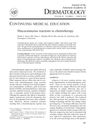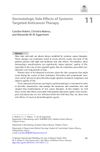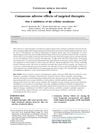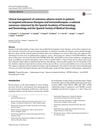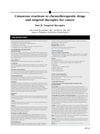Advances in the Management of Cutaneous Toxicities of Targeted Therapies
April 2012
in “
Seminars in Oncology
”
EGFR inhibitors VEGFR inhibitors KIT inhibitors PDGFR inhibitors BCR-ABL inhibitors mTOR inhibitors papulopustular rash paronychia xerosis hair changes mucositis edema rashes pruritus alopecia anti-angiogenic agents sorafenib sunitinib pazopanib hand-foot-skin reaction subungual splinter hemorrhages erythematous rashes epidermal growth factor receptor inhibitors vascular endothelial growth factor receptor inhibitors platelet-derived growth factor receptor inhibitors mammalian target of rapamycin inhibitors skin rash nail infection dry skin hair loss mouth inflammation swelling itching anti-angiogenic drugs Nexavar Sutent Votrient hand-foot syndrome nail bed hemorrhages red rashes
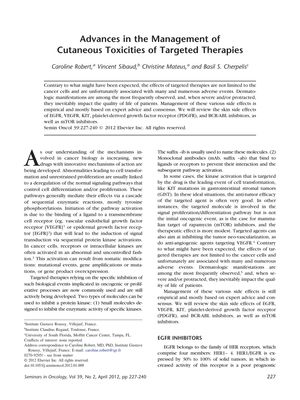
TLDR Targeted cancer therapies often cause skin problems that need careful management to improve patient quality of life and treatment success.
The document from April 2012 reviews the dermatologic side effects of targeted cancer therapies, including inhibitors of EGFR, VEGFR, KIT, PDGFR, BCR-ABL, and mTOR. It highlights that these therapies, while aimed at cancer cells, often result in skin manifestations that can significantly affect patients' quality of life. EGFR inhibitors are noted to cause a papulopustular rash in over 75% of patients, with severity being dose-dependent and associated with better tumor response and survival. Other side effects include paronychia, xerosis, hair changes, and mucositis, with long-term effects like hair changes and xerosis persisting beyond 6 months. The document also discusses the management of skin toxicities from KIT and BCR-ABL inhibitors, which are generally mild to moderate and include edema, rashes, pruritus, alopecia, and xerosis. Anti-angiogenic agents like sorafenib, sunitinib, and pazopanib cause hand-foot-skin reaction, subungual splinter hemorrhages, erythematous rashes, and hair modifications, with alopecia reported in 21% to 44% of patients on sorafenib, 5% to 21% on sunitinib, and 8% to 10% on pazopanib. The document stresses the importance of managing these side effects through patient education, topical and systemic treatments, and collaboration between prescribers and dermatologists to improve patient quality of life and treatment adherence.
